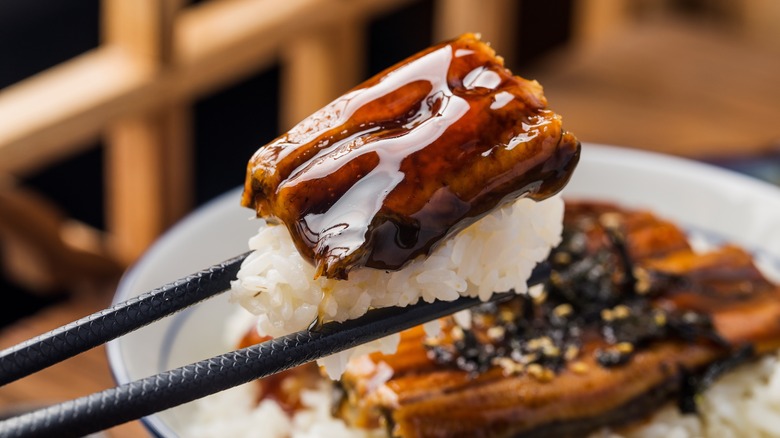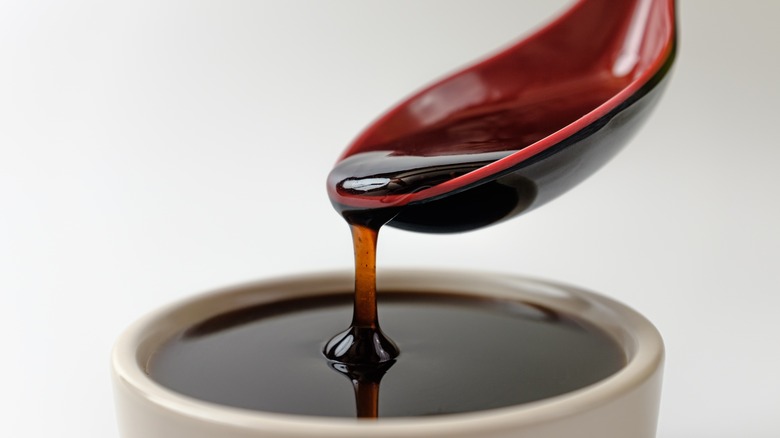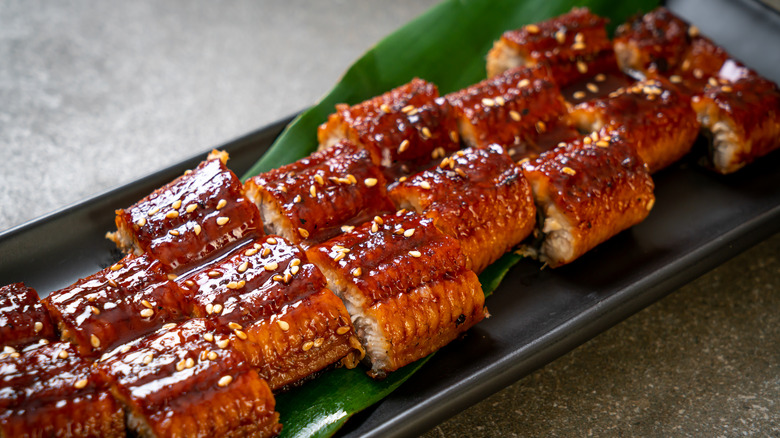Plot Twist — Eel Sauce Isn't Made Of Anything Fishy
If you've ever enjoyed an eel and rice bowl or a piece of unagi nigiri, then you've had eel sauce. This thick, sweet-and-savory sauce is called unagi no tare in Japanese, as "unagi" refers to eel and "tare" refers to sauces used as a glaze or dip. Eel can be enjoyed in many ways, but this sauce is usually used for grilled eel, called unagi kabayaki. Historically, this special sauce was also made with eel broth. Today, however, the sauce itself is rarely made with anything from the sea. Its name generally refers to what it's served with, not how it is made.
Eel sauce relies on the classic Japanese combination of soy sauce, sugar, sake, and mirin (a sweet cooking wine.) These ingredients are simmered together until a thick, glaze-like condiment is formed. It has an intensely savory flavor from the soy sauce, while the sake and mirin provide tang, sweetness, and brightness. It should have a texture that is thick and glossy, while still being pourable. It's best to turn to dry mirin and sake for the sauce. A sweeter or rounder sake can throw the balance off, making the dish (which already contains sugar) too sweet.
How to use eel sauce
Both freshwater and seawater eels are enjoyed in Japan, but unagi sauce is usually eaten with the freshwater variety. This condiment also has many other uses beyond its namesake. Because unagi is grilled, the sauce work well with other grilled foods. This includes dishes like yakitori, a popular Japanese bar food of skewered chicken cooked over hot coals and glazed with sauce. Yakitori is usually glazed with its own tare, which might slightly differ from unagi no tare, but eel sauce can work just as well.
In America, eel sauce is found on plenty of other sushi preparations that use different fish. Similarly, you can use the sauce to flavor the filling in onigiri rice balls. Try it with pork belly onigiri. And since most modern eel sauce is actually vegan, it can add big umami flavors to vegetarian dishes like fried tofu or grilled eggplant.
Eel sauce will also keep for a long time. In Japan, unagi restaurants use the same batch of sauce for years, making more and adding it to the original base as needed. The sauce is consistently sterilized through the cooking process. For home cooks, it's probably best to play it safe and only keep eel sauce in the fridge for up to three months. Bottled or homemade versions of this condiment last a while because they're packed with salt and sugar.
The history of eel sauce
Eel has been eaten in Japan for centuries, with a poem from the 8th century extolling the virtues of catching and eating this animal. The popularity of unagi kabayaki can be traced to the Edo Period, which lasted from 1603 to 1868. Legend says that the dish spiked in popularity due to the efforts of 18th century polymath and inventor Hiraga Gennai, who popularized eating eel on the Day of the Ox.
Known as "Ushi no Hi" in Japanese, this day comes four times a year, but is most famously commemorated in the middle of summer. The idea was that eating unagi, which also starts with a "u," would bring good fortune on this day, and the rich eel would banish summer fatigue and keep one's strength up. Butterflied and grilled unagi became a staple during this period.
Unagi sauce was developed concurrently with this style of preparing eel. A lighter sauce was first used, but when Japan's soy sauce and sugar industries grew and began churning out more product, the thicker unagi sauce was born. Unagi is predominantly eaten in two styles today. In the Tokyo or Kanto style, the eel is grilled, steamed, grilled again, then sauced. This causes the eel to plump up, and it gives it a softer texture. In the Osaka style, the eel is cooked only via grilling and is brushed with the sauce throughout. This gives it a crispier texture, and the sauce has a stronger presence.



